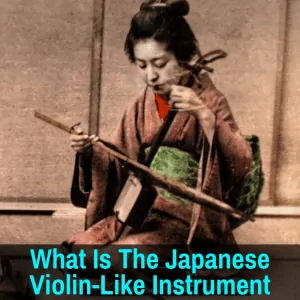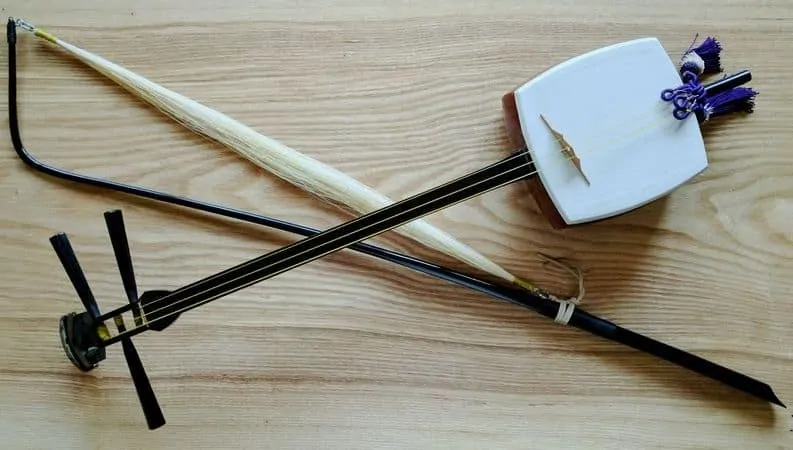
And it sounds totally different, too.
You may have seen this unusual stringed instrument, that is played with a bow, in a Japanese movie and wondered what it was.
Well, if it was indeed a Japanese movie, it was most likely a kokyu.
But if the movie was Chinese or set in China, the instrument was probably an erhu.
Both instruments have strings and are played with a bow, but apart from that, they do not much resemble the violin.
I’ll cover both of them below, since they look very similar to the untrained eye, and whenever someone refers to a Japanese or Chinese violin-like instrument, it is always one of the two they are asking about.
Kokyu — The Japanese Violin-Like Instrument

The kokyu (written 胡弓) is the only Japanese string instrument that is played with a bow. It originally came to Japan from China, but has since evolved and today, the material, shape and sound are distinct from any Chinese instrument.
A kokyu is about 28 inches tall (70 cm). The body is hollow and made from coconut or Styrax japonica wood. Both ends of the body are covered in cat skin. The neck is made from ebony and it usually has three strings, though there are variations with 4.
The bow is made from horsetail hair. It is rubbed against the strings to produce sound and the instrument is held upright, not unlike a cello. It is much smaller than a cello, though.
Traditionally, the kokyu was used as a part of the sankyoku ensemble, a form of Japanese chamber music that is often accompanied by a vocalist. These days, the kokyu is usually replaced by the shakuhachi, a Japanese flute.
In recent times, the kokyu has regained popularity and there is even a kokyu society. It has also been used in jazz and blues. Here is a good video demonstrating the kokyu.
Erhu — The Chinese Violin-Like Instrument

The bottom of an erhu has a small resonator box made some type of hardwood (various types are commonly used). It is covered by a python skin, although the Hong Kong Symphony orchestra has managed to engineer a synthetic alternative, which may be used in the future.
A long, thin vertical neck sticks out of the sound box with two large tuning pegs at the top. Two strings run from the pegs to the base, held in place against a bridge by a small loop of string. Both the instrument and the bow typically measure 81 cm.
Unlike western string instruments like the violin, the horsehair bow used with an erhu does not glide over the strings, but is permanently connected to the strings and passes between them.
The sound is produced by the vibration of the python skin covering the sound box. There is no fingerboard. The strings are stopped by pressing them inward with the fingers, but they never touch the neck. They are very close to each other, so they are basically played like one string.
When playing, the erhu is placed with the resonator box on the left thigh and the neck sticking upward. It is sometimes also played while standing with the instrument attached to a belt clip.
The right hand of the player holds the bow and uses the fingers to push the hairs outward to create tension. The bow goes between the strings with both sides producing sound. The inside string is played when pulling the bow towards the body and the outside string on the movement away from the instrumentalist. The left hand is used to press the strings, altering the pitch.
The inside string of an erhu is usually tuned to D4 and the outside one to A4. This means they are tuned the same as a standard violin is on the two middle strings. As a result, an erhu has a much more limited range than a violin.
Here is a video demonstrating the erhu.
Traditional Japanese String Instrument: Final Thoughts
The traditional string instrument many refer to as the Japanese violin is the kokyu. But often, people confuse it with the Chinese stringed instrument called the erhu.
The two are quite different, but the kokyu originally came from China to Japan. It evolved quite a bit and is now a very different instrument.
Further Reading
- Japanese Instruments on the PBS website
- Chinese Instruments on the China Highlights site
Leave a Reply